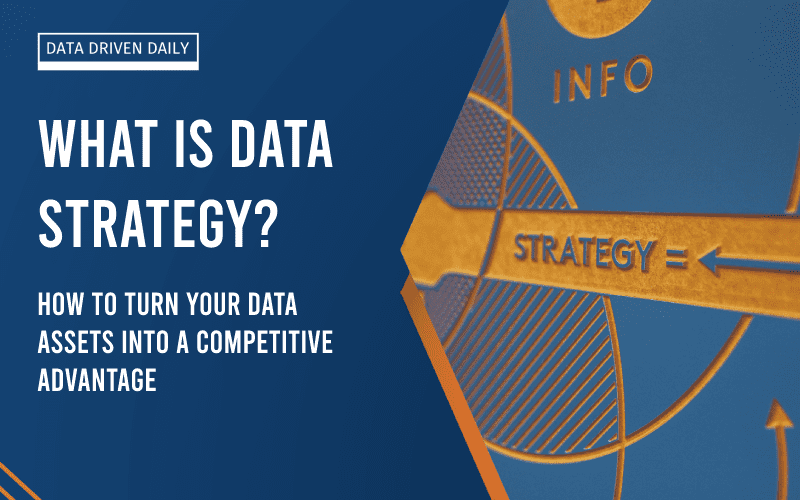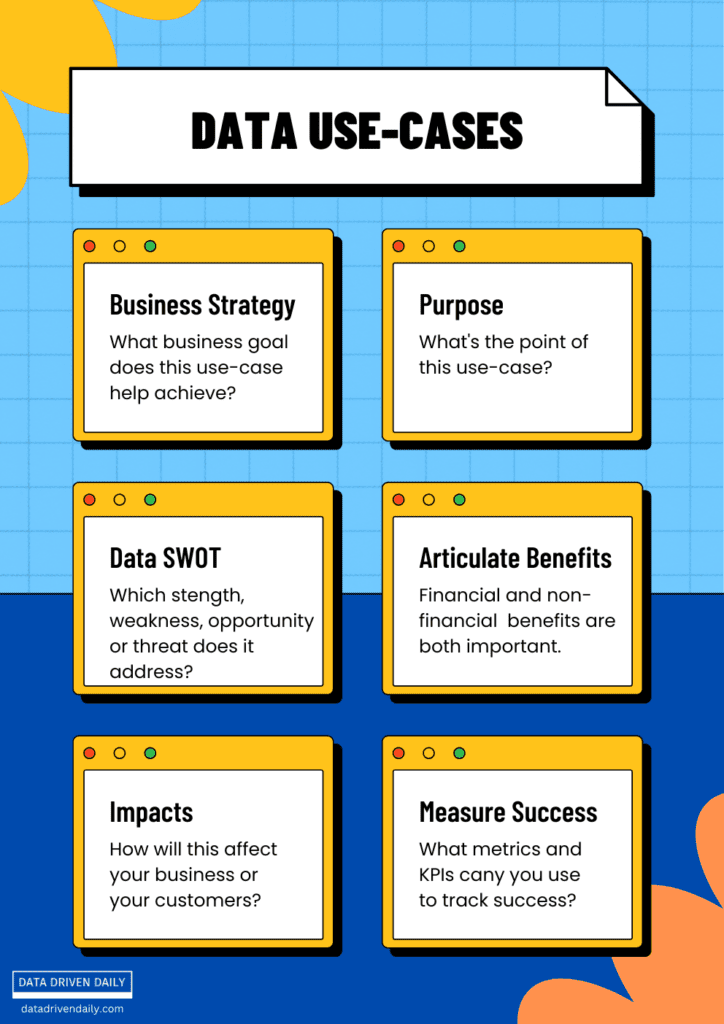Unlocking the immense potential of data remains a critical priority for organizations seeking to stay competitive in an ever-changing landscape. According to a McKinsey study, data-driven organizations are 23 times more likely to acquire customers, 6 times more likely to retain them, and 19 times more likely to be profitable.
As a data professional, your ability to understand and implement an effective data strategy can be a game-changer for your organization.

This comprehensive guide aims to equip you with the knowledge and insights necessary to develop and execute a successful data strategy. We will delve into the essential components of data strategy, its importance, best practices, and the various roles, tools, and technologies involved.
What is Data Strategy?
Data strategy is a holistic plan that guides an organization’s data management, analysis, and governance efforts to align with its business objectives.
A well-designed data strategy ensures that data is collected, stored, processed, and utilized effectively, enabling data-driven decision-making and maximizing the value of data assets.
Data strategy is often an overlooked or undervalued component of an organization’s general business strategy – don’t neglect this important element of success.
Key Components of Data Strategy
An effective data strategy consists of several key components:
Data identification and discovery
Identifying the types of data needed, their sources, and how to access them. Including a data sourcing strategy.
Data collection and storage
Collecting, storing, and organizing data in a way that supports efficient retrieval and analysis.
Data quality and integrity
Ensuring the accuracy, consistency, completeness, and validity of data throughout its lifecycle.
Data privacy and security
Protecting data from unauthorized access, ensuring compliance with relevant regulations, and respecting user privacy.
Data integration and processing
Combining and processing data from multiple sources to create a unified view and support advanced analytics.
Data analysis and visualization
Analyzing and visualizing data to generate insights and inform decision-making.
Data dissemination and sharing
Sharing data and insights with relevant stakeholders, both internally and externally.
Data governance and compliance
Establishing policies, procedures, and standards for managing data, ensuring data quality, integrity, and compliance.
Developing a Data Strategy
To develop a successful data strategy, consider the following steps:
Identifying business objectives and goals
Determine the strategic goals and objectives that your data strategy should support.
Assessing data maturity, and assessment of capabilities
Evaluate your organization’s current data capabilities and maturity level to identify strengths, weaknesses, and areas for improvement.
Defining data-related roles and responsibilities
Establish clear roles and responsibilities for data management, governance, and analytics.
Aligning data strategy with business strategy
Ensure that your data strategy supports and complements your organization’s overall business strategy.
Creating a data strategy roadmap
Develop a roadmap outlining the key initiatives, milestones, and resources needed to implement your data strategy.
Implementing and executing the data strategy
Put your data strategy into action, monitoring progress and adjusting as needed.
Conducting a data SWOT analysis
Assess the strengths, weaknesses, opportunities, and threats related to your organization’s data assets and capabilities.
Data strategy use cases
Identify specific use cases where your data strategy can deliver tangible value and help achieve your organization’s objectives.

Measuring data strategy success
Monitor and evaluate the progress of your data strategy roadmap with appropriate KPIs and metrics.
Avoid common data strategy mistakes
Use the learnings from others before you forge ahead, avoid common pitfalls when you are implementing your data strategy.
Data Strategy for Small Business
Apply these data strategy techniques through the lens of a small business.
Data Monetization
How can you use data for further profit in your organization?
Data Infrastructure and Architecture
An effective data strategy requires a robust data infrastructure and architecture that supports the collection, storage, integration, processing, and analysis of data. Key components include:
Data storage solutions
Databases, data warehouses, and data lakes for storing structured and unstructured data.
Data integration technologies
ETL (Extract, Transform, Load), ELT (Extract, Load, Transform), APIs, and data pipelines for integrating data from different sources.
Data processing and analytics frameworks
Hadoop, Spark, and other big data processing frameworks for scalable data processing and analysis.
Data visualization and reporting tools
Tableau, Power BI, and other tools for creating interactive visualizations and reports to communicate insights effectively.
Cloud-based data platforms
AWS, GCP, and Azure, which offer scalable and flexible data storage, processing, and analytics services.
Data Quality, Integrity, and Lifecycle
Maintaining data quality and integrity is essential for deriving accurate and reliable insights. Consider the following best practices:
Data quality dimensions
Focus on accuracy, consistency, completeness, and other dimensions of data quality.
Data quality management best practices
Implement processes to monitor, validate, and improve data quality.
Data validation and cleansing techniques
Employ techniques such as data profiling, cleansing, and deduplication to ensure data quality.
Data profiling and monitoring tools
Utilize tools to automate data quality monitoring and identify potential issues.
Understanding and managing the data lifecycle helps ensure that data is effectively managed from creation to disposal:
Overview of the data lifecycle
Familiarize yourself with the key stages in the data lifecycle, including creation, storage, usage, archiving, and disposal. Data democratization.
Key stages in the data lifecycle
Ensure proper management at each stage to maximize data value and maintain compliance.
Managing data throughout its lifecycle
Implement policies and procedures for handling data at each stage of its lifecycle.
Data Privacy, Security, and Compliance
Protecting data privacy and ensuring security are crucial aspects of data strategy:
Data protection principles and regulations
Stay informed about GDPR, CCPA, HIPAA, and other data protection regulations, and ensure compliance.
Data classification and handling
Classify data based on sensitivity and apply appropriate handling procedures.
Data encryption and anonymization techniques
Employ encryption and anonymization techniques to protect sensitive data.
Data access control and management
Implement access controls and manage user permissions to prevent unauthorized data access.
Data governance and compliance play a vital role in maintaining data quality, integrity, and compliance:
Data governance framework and components
Establish a data governance framework with clear policies, standards, and procedures.
Data stewardship and ownership
Assign data stewards and owners to ensure accountability for data quality and governance.
Data policies, standards, and procedures
Develop and enforce policies, standards, and procedures to guide data management and governance.
Data governance tools and technologies
Utilize tools and technologies to support data governance efforts.
Data Modeling, Operations, and Metadata
Data modeling, operations, and metadata are essential elements of a successful data strategy:
Importance of data modeling
Understand the role of data modeling in defining data structures, relationships, and constraints.
Types of data models
Explore conceptual, logical, and physical data models, and apply them to your data strategy.
Data modeling best practices
Follow best practices for designing and maintaining data models.
Data operations involve the processes and technologies for managing data throughout its lifecycle:
Definition of data operations
Familiarize yourself with the components of data operations, including ingestion, processing, and storage.
Challenges and best practices in data operations
Identify and address common challenges, and follow best practices for efficient data operations.
Metadata provides context and improves understanding and usability of data assets:
The role of metadata in data strategy
Recognize the importance of metadata for managing, organizing, and discovering data.
Types of metadata
Understand technical, business, and operational metadata, and incorporate them into your data strategy.
Metadata management best practices
Implement best practices for managing and maintaining metadata.
Building a Data-Driven Organization
To fully leverage the benefits of a data strategy, organizations must foster a data-driven culture and develop relevant skills:
Fostering a data -driven culture
Encourage data-driven decision-making and collaboration across the organization.
Importance of data literacy and training
Invest in training programs to develop data literacy and analytical skills among employees.
Data-driven decision making and collaboration
Foster a culture where data is used to inform decisions and enhance collaboration among teams.
Overcoming common challenges and measuring the success of your data strategy are essential for long-term growth:
Overcoming common data strategy challenges
Address issues such as data silos, lack of data ownership, and insufficient resources.
Evaluating and measuring data strategy success
Establish key performance indicators (KPIs) and metrics to assess the effectiveness of your data strategy.
Building a strong team with relevant expertise is critical for executing a successful data strategy:
Key roles and responsibilities in data strategy
Understand the roles of data strategists, data architects, data stewards, and others in your data strategy team.
Finding and keeping talent in data strategy roles
Attract and retain skilled professionals to support your organization’s data strategy efforts.
Data strategy for non-profits
Requiring a slightly different approach to for-profit businesses.
Data Strategy Certifications and Education
Continued education and professional development play a vital role in staying up-to-date with the latest advancements in data strategy. Pursuing relevant certifications and participating in educational programs can help you and your team build the necessary skills and expertise.
Importance of certifications and education
Understand the value of obtaining certifications and participating in educational programs to enhance your data strategy knowledge and skills.
Popular data strategy certifications
Explore various certifications related to data strategy, such as Certified Data Management Professional (CDMP), Data Governance and Stewardship Professional (DGSP), and Certified Information Management Professional (CIMP).
Vendor-specific certifications
Learn about certifications offered by major data platform vendors, such as AWS Certified Data Analytics, Google Cloud Data Engineer, and Microsoft Certified: Azure Data Engineer Associate.
Data strategy courses and training programs
Discover reputable courses and training programs that cover essential data strategy topics, offered by universities, online learning platforms, and industry organizations.
Data strategy workshops and conferences
Attend workshops, seminars, and conferences focused on data strategy to stay informed about the latest trends and network with other professionals in the field.
Online resources for data strategy learning
Utilize blogs, podcasts, webinars, and online forums to stay updated on data strategy topics and learn from industry experts.
Programs for data executives and senior leaders
Something pitched at a senior level for c-suites and other executives can be a game changer on your resume.
Future of data strategy
What does 5 years, 10 years in the future look like for the data strategy world?
Wrapping up
This comprehensive guide serves as a starting point for understanding and developing a successful data strategy. By implementing the best practices and recommendations outlined in this guide, you will be well-equipped to maximize the value of your organization’s data assets and drive data-driven decision-making. Remember to check back for updated content and links to more detailed child pages on each topic.
Ben is a full-time data leadership professional and a part-time blogger.
When he’s not writing articles for Data Driven Daily, Ben is a Head of Data Strategy at a large financial institution.
He has over 14 years’ experience in Banking and Financial Services, during which he has led large data engineering and business intelligence teams, managed cloud migration programs, and spearheaded regulatory change initiatives.